technical specifications Seat Mii 2013 Owner's Guide
[x] Cancel search | Manufacturer: SEAT, Model Year: 2013, Model line: Mii, Model: Seat Mii 2013Pages: 306, PDF Size: 4.3 MB
Page 45 of 306

43
Opening and closing
Side-opening rear windows
Fig. 25 Lever to open
and close the rear win-
dow
Opening
Pull the release lever in the direction of the arrow A
and press outwards
until the lever engages.
Closing
Pull the release lever in the direction of the arrow B
and then press the lev-
er backwards until it engages. Opening and closing the sliding/tilting
electric panoramic sunroof
Introduction
Additional information and warnings:
● Central locking and locking system ⇒ page 32
● Roof carrier ⇒ page 104
WARNING
If the sliding/tilting electric panoramic sunroof is used negligently or
without paying due attention, it can cause serious injury.
● The sliding/tilting sunroof should only be opened or closed when no
person remains in the way of it.
● After switching off, it is still possible to open or close the sliding/tilt-
ing sunroof during a short space of time provided that neither the driver
nor passenger door is opened.
CAUTION
● To prevent damage, when there are winter temperatures any ice or snow
that there may be on the roof of the vehicle must be removed before open-
ing or raising the sliding/tilting electric panoramic sunroof.
● Before leaving the vehicle or in the case of heavy rain, the sliding/tilting
sunroof must always be closed. With the sliding/tilting sunroof open or
raised, water can enter the passenger compartment and can cause consid-
erable damage to the electrical system. As a result, other damage can occur
in the vehicle.
● In the case of heavy rain, if the sliding/tilting sunroof is open, the interi-
or equipment of the vehicle may get wet, destroying the seat heating and
damaging the electrical system of the vehicle.
Vehicle diagramPrior to a journey...While drivingCare, cleaning and mainte-
nanceIf and whenTechnical specifications
Page 47 of 306
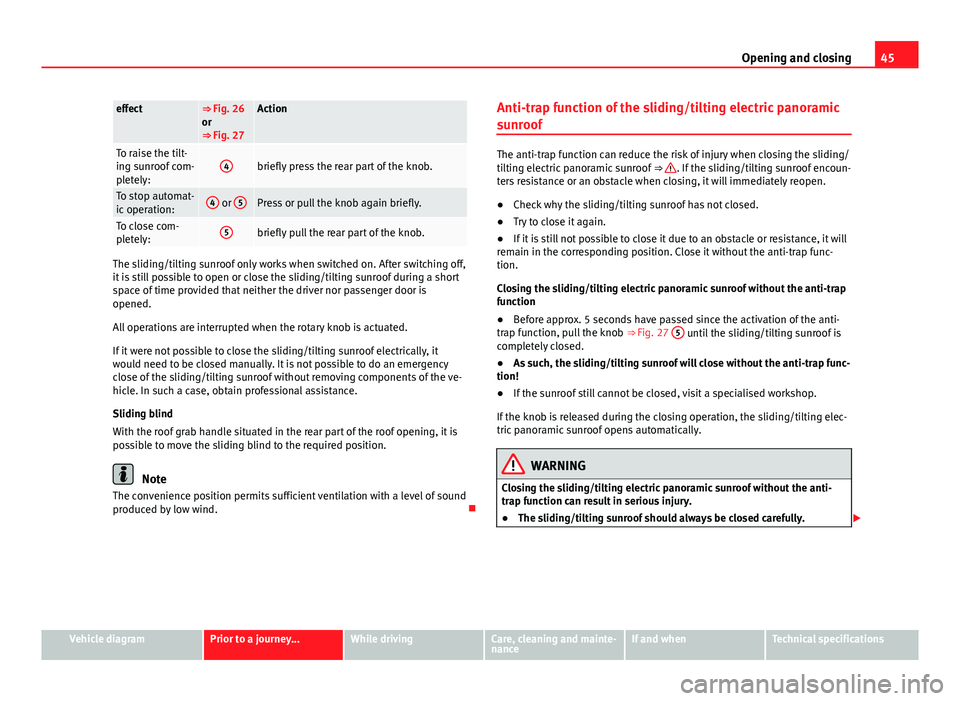
45
Opening and closing
effect⇒ Fig. 26
or
⇒ Fig. 27Action
To raise the tilt-
ing sunroof com-
pletely:4briefly press the rear part of the knob.
To stop automat-
ic operation:4 or 5Press or pull the knob again briefly.
To close com-
pletely:5briefly pull the rear part of the knob.
The sliding/tilting sunroof only works when switched on. After switching off,
it is still possible to open or close the sliding/tilting sunroof during a short
space of time provided that neither the driver nor passenger door is
opened.
All operations are interrupted when the rotary knob is actuated.
If it were not possible to close the sliding/tilting sunroof electrically, it
would need to be closed manually. It is not possible to do an emergency
close of the sliding/tilting sunroof without removing components of the ve-
hicle. In such a case, obtain professional assistance.
Sliding blind
With the roof grab handle situated in the rear part of the roof opening, it is
possible to move the sliding blind to the required position.
Note
The convenience position permits sufficient ventilation with a level of sound
produced by low wind. Anti-trap function of the sliding/tilting electric panoramic
sunroof
The anti-trap function can reduce the risk of injury when closing the sliding/
tilting electric panoramic sunroof
⇒ . If the sliding/tilting sunroof encoun-
ters resistance or an obstacle when closing, it will immediately reopen.
● Check why the sliding/tilting sunroof has not closed.
● Try to close it again.
● If it is still not possible to close it due to an obstacle or resistance, it will
remain in the corresponding position. Close it without the anti-trap func-
tion.
Closing the sliding/tilting electric panoramic sunroof without the anti-trap
function
● Before approx. 5 seconds have passed since the activation of the anti-
trap function, pull the knob ⇒ Fig. 27 5
until the sliding/tilting sunroof is
completely closed.
● As such, the sliding/tilting sunroof will close without the anti-trap func-
tion!
● If the sunroof still cannot be closed, visit a specialised workshop.
If the knob is released during the closing operation, the sliding/tilting elec-
tric panoramic sunroof opens automatically.
WARNING
Closing the sliding/tilting electric panoramic sunroof without the anti-
trap function can result in serious injury.
● The sliding/tilting sunroof should always be closed carefully.
Vehicle diagramPrior to a journey...While drivingCare, cleaning and mainte-
nanceIf and whenTechnical specifications
Page 49 of 306
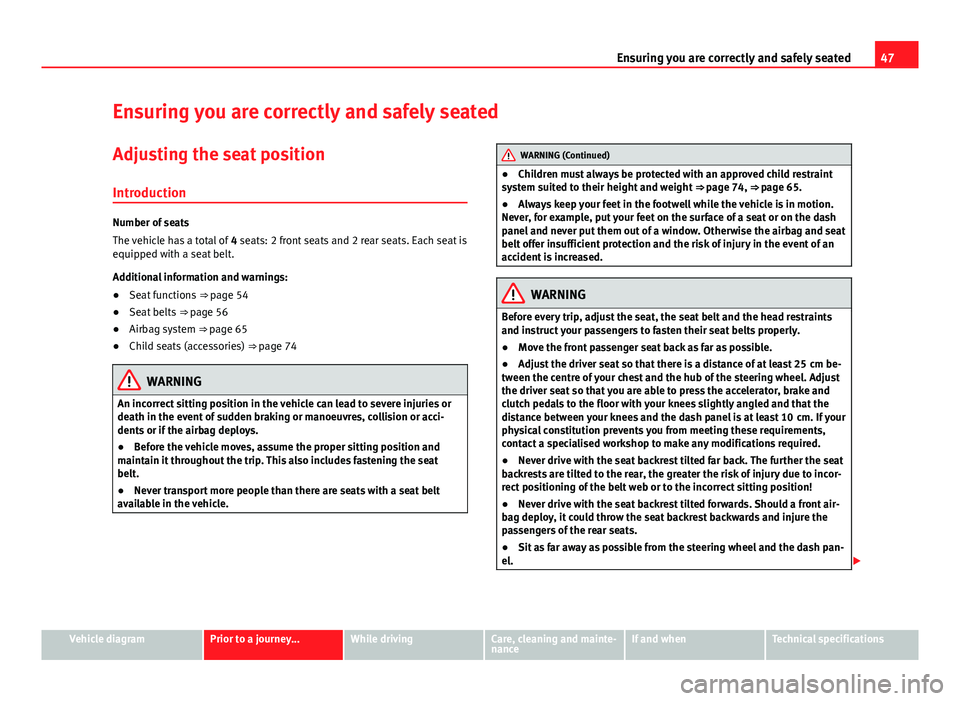
47
Ensuring you are correctly and safely seated
Ensuring you are correctly and safely seated Adjusting the seat position
Introduction
Number of seats
The vehicle has a total of 4 seats: 2 front seats and 2 rear seats. Each seat is
equipped with a seat belt.
Additional information and warnings:
● Seat functions ⇒ page 54
● Seat belts ⇒ page 56
● Airbag system ⇒ page 65
● Child seats (accessories) ⇒ page 74
WARNING
An incorrect sitting position in the vehicle can lead to severe injuries or
death in the event of sudden braking or manoeuvres, collision or acci-
dents or if the airbag deploys.
● Before the vehicle moves, assume the proper sitting position and
maintain it throughout the trip. This also includes fastening the seat
belt.
● Never transport more people than there are seats with a seat belt
available in the vehicle.
WARNING (Continued)
● Children must always be protected with an approved child restraint
system suited to their height and weight ⇒ page 74, ⇒ page 65.
● Always keep your feet in the footwell while the vehicle is in motion.
Never, for example, put your feet on the surface of a seat or on the dash
panel and never put them out of a window. Otherwise the airbag and seat
belt offer insufficient protection and the risk of injury in the event of an
accident is increased.
WARNING
Before every trip, adjust the seat, the seat belt and the head restraints
and instruct your passengers to fasten their seat belts properly.
● Move the front passenger seat back as far as possible.
● Adjust the driver seat so that there is a distance of at least 25 cm be-
tween the centre of your chest and the hub of the steering wheel. Adjust
the driver seat so that you are able to press the accelerator, brake and
clutch pedals to the floor with your knees slightly angled and that the
distance between your knees and the dash panel is at least 10 cm. If your
physical constitution prevents you from meeting these requirements,
contact a specialised workshop to make any modifications required.
● Never drive with the seat backrest tilted far back. The further the seat
backrests are tilted to the rear, the greater the risk of injury due to incor-
rect positioning of the belt web or to the incorrect sitting position!
● Never drive with the seat backrest tilted forwards. Should a front air-
bag deploy, it could throw the seat backrest backwards and injure the
passengers of the rear seats.
● Sit as far away as possible from the steering wheel and the dash pan-
el.
Vehicle diagramPrior to a journey...While drivingCare, cleaning and mainte-
nanceIf and whenTechnical specifications
Page 51 of 306
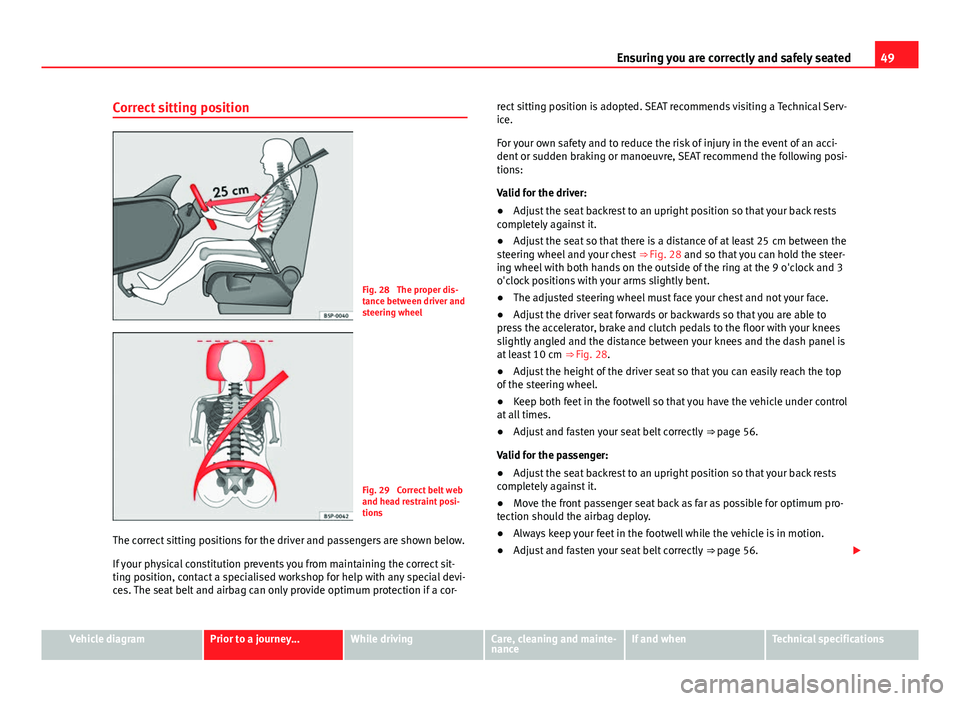
49
Ensuring you are correctly and safely seated
Correct sitting position
Fig. 28 The proper dis-
tance between driver and
steering wheel
Fig. 29 Correct belt web
and head restraint posi-
tions
The correct sitting positions for the driver and passengers are shown below.
If your physical constitution prevents you from maintaining the correct sit-
ting position, contact a specialised workshop for help with any special devi-
ces. The seat belt and airbag can only provide optimum protection if a cor- rect sitting position is adopted. SEAT recommends visiting a Technical Serv-
ice.
For your own safety and to reduce the risk of injury in the event of an acci-
dent or sudden braking or manoeuvre, SEAT recommend the following posi-
tions:
Valid for the driver:
●
Adjust the seat backrest to an upright position so that your back rests
completely against it.
● Adjust the seat so that there is a distance of at least 25 cm between the
steering wheel and your chest ⇒ Fig. 28 and so that you can hold the steer-
ing wheel with both hands on the outside of the ring at the 9 o'clock and 3
o'clock positions with your arms slightly bent.
● The adjusted steering wheel must face your chest and not your face.
● Adjust the driver seat forwards or backwards so that you are able to
press the accelerator, brake and clutch pedals to the floor with your knees
slightly angled and the distance between your knees and the dash panel is
at least 10 cm ⇒ Fig. 28.
● Adjust the height of the driver seat so that you can easily reach the top
of the steering wheel.
● Keep both feet in the footwell so that you have the vehicle under control
at all times.
● Adjust and fasten your seat belt correctly ⇒ page 56.
Valid for the passenger:
● Adjust the seat backrest to an upright position so that your back rests
completely against it.
● Move the front passenger seat back as far as possible for optimum pro-
tection should the airbag deploy.
● Always keep your feet in the footwell while the vehicle is in motion.
● Adjust and fasten your seat belt correctly ⇒ page 56.
Vehicle diagramPrior to a journey...While drivingCare, cleaning and mainte-
nanceIf and whenTechnical specifications
Page 53 of 306
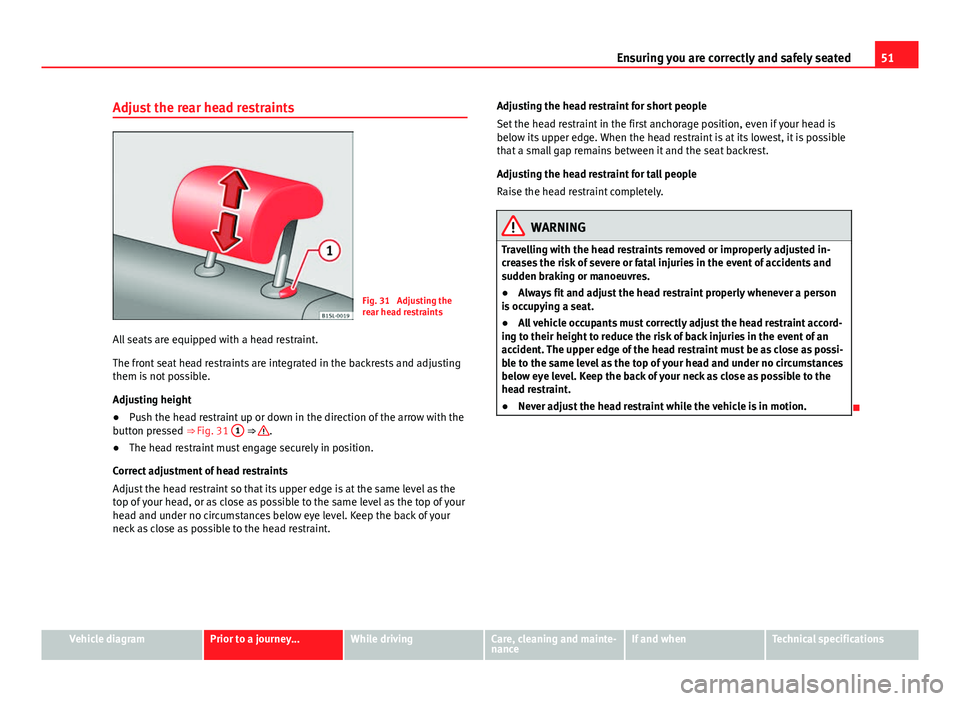
51
Ensuring you are correctly and safely seated
Adjust the rear head restraints
Fig. 31 Adjusting the
rear head restraints
All seats are equipped with a head restraint.
The front seat head restraints are integrated in the backrests and adjusting
them is not possible.
Adjusting height
● Push the head restraint up or down in the direction of the arrow with the
button pressed ⇒ Fig. 31 1
⇒ .
● The head restraint must engage securely in position.
Correct adjustment of head restraints
Adjust the head restraint so that its upper edge is at the same level as the
top of your head, or as close as possible to the same level as the top of your
head and under no circumstances below eye level. Keep the back of your
neck as close as possible to the head restraint. Adjusting the head restraint for short people
Set the head restraint in the first anchorage position, even if your head is
below its upper edge. When the head restraint is at its lowest, it is possible
that a small gap remains between it and the seat backrest.
Adjusting the head restraint for tall people
Raise the head restraint completely.
WARNING
Travelling with the head restraints removed or improperly adjusted in-
creases the risk of severe or fatal injuries in the event of accidents and
sudden braking or manoeuvres.
● Always fit and adjust the head restraint properly whenever a person
is occupying a seat.
● All vehicle occupants must correctly adjust the head restraint accord-
ing to their height to reduce the risk of back injuries in the event of an
accident. The upper edge of the head restraint must be as close as possi-
ble to the same level as the top of your head and under no circumstances
below eye level. Keep the back of your neck as close as possible to the
head restraint.
● Never adjust the head restraint while the vehicle is in motion.
Vehicle diagramPrior to a journey...While drivingCare, cleaning and mainte-
nanceIf and whenTechnical specifications
Page 55 of 306
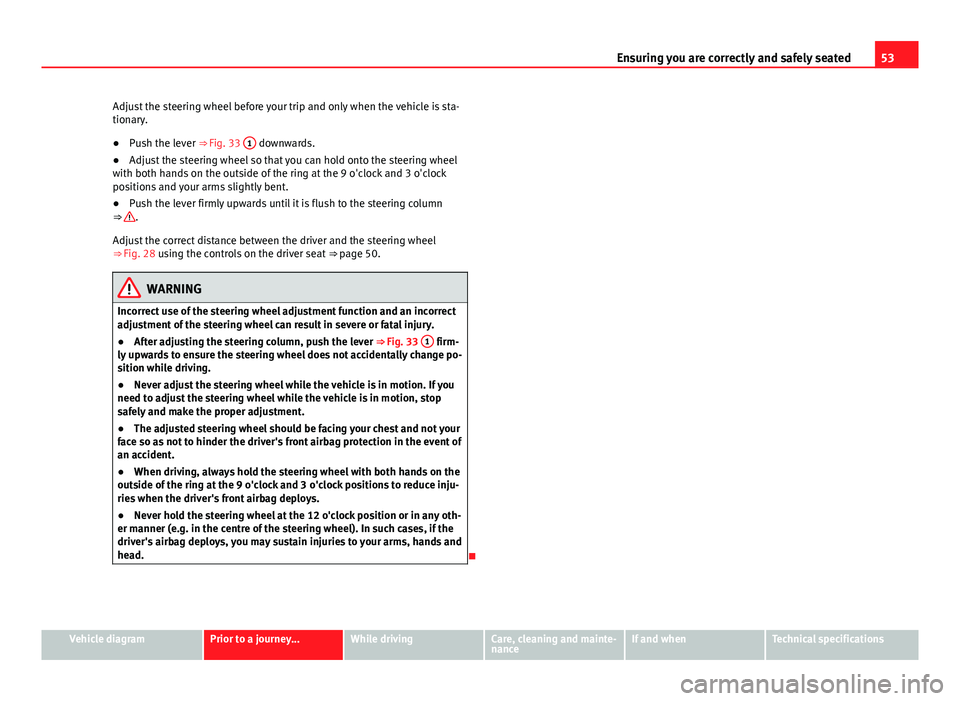
53
Ensuring you are correctly and safely seated
Adjust the steering wheel before your trip and only when the vehicle is sta-
tionary.
● Push the lever ⇒ Fig. 33 1
downwards.
● Adjust the steering wheel so that you can hold onto the steering wheel
with both hands on the outside of the ring at the 9 o'clock and 3 o'clock
positions and your arms slightly bent.
● Push the lever firmly upwards until it is flush to the steering column
⇒
.
Adjust the correct distance between the driver and the steering wheel
⇒ Fig. 28 using the controls on the driver seat ⇒ page 50.
WARNING
Incorrect use of the steering wheel adjustment function and an incorrect
adjustment of the steering wheel can result in severe or fatal injury.
● After adjusting the steering column, push the lever ⇒ Fig. 33 1
firm-
ly upwards to ensure the steering wheel does not accidentally change po-
sition while driving.
● Never adjust the steering wheel while the vehicle is in motion. If you
need to adjust the steering wheel while the vehicle is in motion, stop
safely and make the proper adjustment.
● The adjusted steering wheel should be facing your chest and not your
face so as not to hinder the driver's front airbag protection in the event of
an accident.
● When driving, always hold the steering wheel with both hands on the
outside of the ring at the 9 o'clock and 3 o'clock positions to reduce inju-
ries when the driver's front airbag deploys.
● Never hold the steering wheel at the 12 o'clock position or in any oth-
er manner (e.g. in the centre of the steering wheel). In such cases, if the
driver's airbag deploys, you may sustain injuries to your arms, hands and
head.
Vehicle diagramPrior to a journey...While drivingCare, cleaning and mainte-
nanceIf and whenTechnical specifications
Page 57 of 306
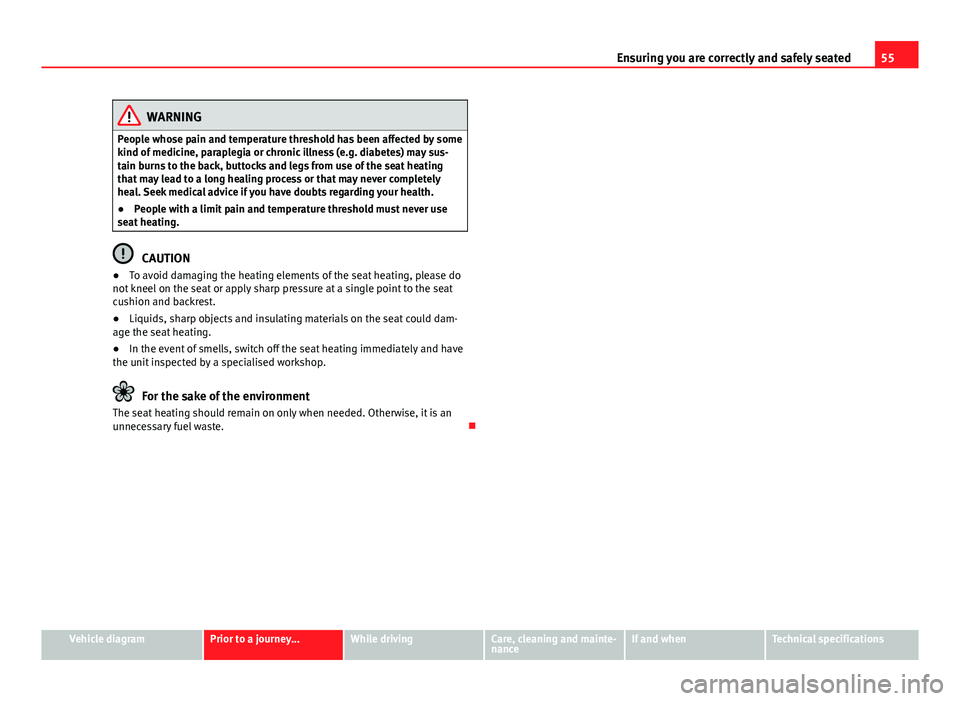
55
Ensuring you are correctly and safely seated
WARNING
People whose pain and temperature threshold has been affected by some
kind of medicine, paraplegia or chronic illness (e.g. diabetes) may sus-
tain burns to the back, buttocks and legs from use of the seat heating
that may lead to a long healing process or that may never completely
heal. Seek medical advice if you have doubts regarding your health.
● People with a limit pain and temperature threshold must never use
seat heating.
CAUTION
● To avoid damaging the heating elements of the seat heating, please do
not kneel on the seat or apply sharp pressure at a single point to the seat
cushion and backrest.
● Liquids, sharp objects and insulating materials on the seat could dam-
age the seat heating.
● In the event of smells, switch off the seat heating immediately and have
the unit inspected by a specialised workshop.
For the sake of the environment
The seat heating should remain on only when needed. Otherwise, it is an
unnecessary fuel waste.
Vehicle diagramPrior to a journey...While drivingCare, cleaning and mainte-
nanceIf and whenTechnical specifications
Page 59 of 306
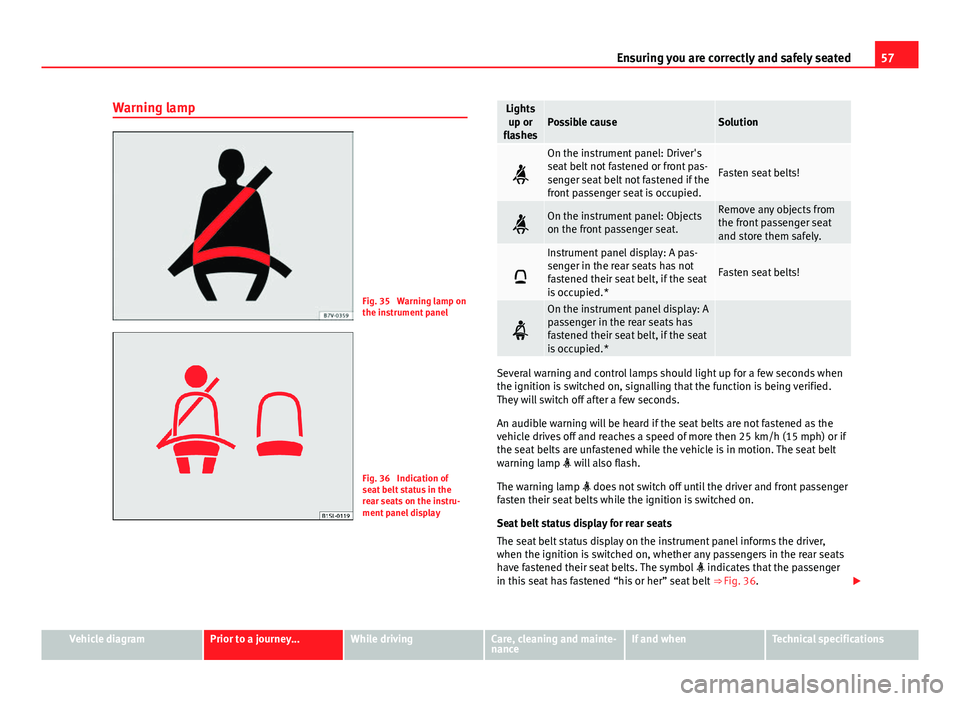
57
Ensuring you are correctly and safely seated
Warning lamp
Fig. 35 Warning lamp on
the instrument panel
Fig. 36 Indication of
seat belt status in the
rear seats on the instru-
ment panel display
Lights up or
flashesPossible causeSolution
On the instrument panel: Driver's
seat belt not fastened or front pas-
senger seat belt not fastened if the
front passenger seat is occupied.
Fasten seat belts!
On the instrument panel: Objects
on the front passenger seat.Remove any objects from
the front passenger seat
and store them safely.
Instrument panel display: A pas-
senger in the rear seats has not
fastened their seat belt, if the seat
is occupied.*
Fasten seat belts!
On the instrument panel display: A
passenger in the rear seats has
fastened their seat belt, if the seat
is occupied.*
Several warning and control lamps should light up for a few seconds when
the ignition is switched on, signalling that the function is being verified.
They will switch off after a few seconds.
An audible warning will be heard if the seat belts are not fastened as the
vehicle drives off and reaches a speed of more then 25 km/h (15 mph) or if
the seat belts are unfastened while the vehicle is in motion. The seat belt
warning lamp will also flash.
The warning lamp does not switch off until the driver and front passenger
fasten their seat belts while the ignition is switched on.
Seat belt status display for rear seats
The seat belt status display on the instrument panel informs the driver,
when the ignition is switched on, whether any passengers in the rear seats
have fastened their seat belts. The symbol indicates that the passenger
in this seat has fastened “his or her” seat belt ⇒ Fig. 36.
Vehicle diagramPrior to a journey...While drivingCare, cleaning and mainte-
nanceIf and whenTechnical specifications
Page 61 of 306

59
Ensuring you are correctly and safely seated
At speeds of 30 km/h (18 mph) to 50 km/h (30 mph), the forces acting on
bodies in a collision can easily exceed one tonne (1000 kg or
2.205 pounds). At greater speed these forces are even higher.
This example applies not only to head-on collisions, but to all accidents and
collisions.
Dangers of not using the seat belt
Fig. 39 A driver not
wearing a seat belt is
thrown forward violently
Fig. 40 The unbelted
rear passenger is thrown
forward violently, hitting
the driver wearing a seat
belt
Many people believe that the vehicle occupants can protect themselves
with their hands in a minor collision. This is false!
Even at low speeds, the forces acting on the body in a collision are so great
that it is not possible to brace oneself with just one's arms and hands. In a
frontal collision, unbelted vehicle occupants are thrown forward and will
make violent contact with the steering wheel, dash panel, windscreen or
whatever else is in the way ⇒ Fig. 39.
The airbag system is not a substitute for seat belts. When triggered, airbags
provide only additional protection. Airbags do not deploy in all types of ac-
cident. All vehicle occupants (including the driver) must be wearing seat
belts properly during the trip, even if the vehicle is equipped with airbag
systems. This will reduce the risk of critical or fatal injuries in the event of an
accident – regardless of whether an airbag is fitted for the seat.
The airbag is only deployed once. To achieve the best possible protection,
the seat belt must always be worn properly so that you will be protected in
accidents in which no airbag is deployed. Vehicle occupants not wearing
belts could be thrown from the vehicle and sustain even more severe or fa-
tal injuries.
Vehicle diagramPrior to a journey...While drivingCare, cleaning and mainte-
nanceIf and whenTechnical specifications
Page 63 of 306
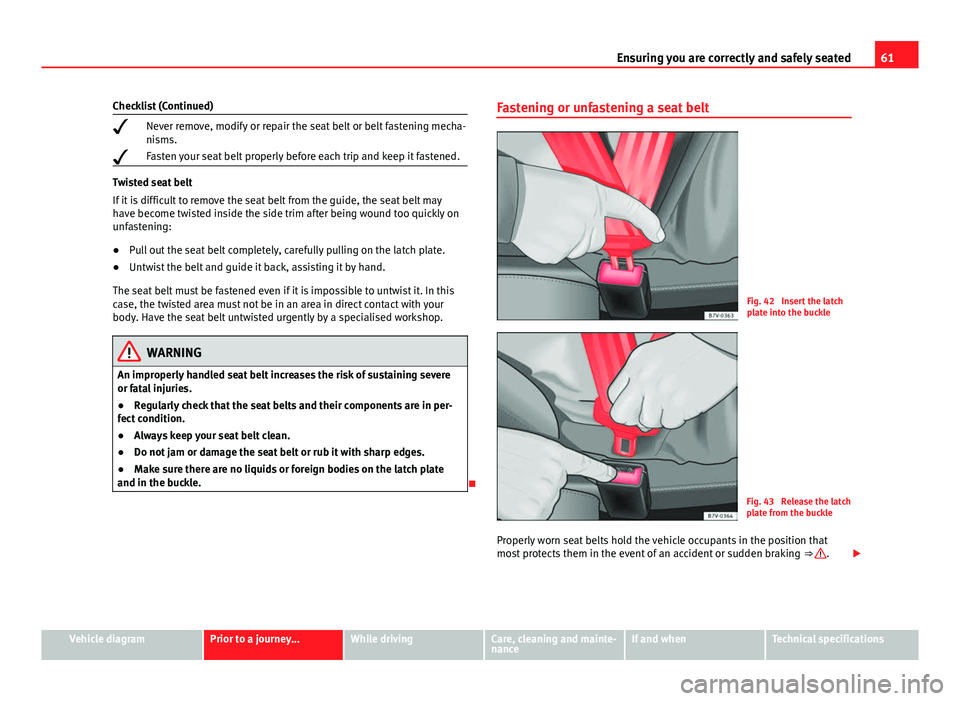
61
Ensuring you are correctly and safely seated
Checklist (Continued)
Never remove, modify or repair the seat belt or belt fastening mecha-
nisms.
Fasten your seat belt properly before each trip and keep it fastened.
Twisted seat belt
If it is difficult to remove the seat belt from the guide, the seat belt may
have become twisted inside the side trim after being wound too quickly on
unfastening:
●
Pull out the seat belt completely, carefully pulling on the latch plate.
● Untwist the belt and guide it back, assisting it by hand.
The seat belt must be fastened even if it is impossible to untwist it. In this
case, the twisted area must not be in an area in direct contact with your
body. Have the seat belt untwisted urgently by a specialised workshop.
WARNING
An improperly handled seat belt increases the risk of sustaining severe
or fatal injuries.
● Regularly check that the seat belts and their components are in per-
fect condition.
● Always keep your seat belt clean.
● Do not jam or damage the seat belt or rub it with sharp edges.
● Make sure there are no liquids or foreign bodies on the latch plate
and in the buckle.
Fastening or unfastening a seat belt
Fig. 42 Insert the latch
plate into the buckle
Fig. 43 Release the latch
plate from the buckle
Properly worn seat belts hold the vehicle occupants in the position that
most protects them in the event of an accident or sudden braking ⇒
.
Vehicle diagramPrior to a journey...While drivingCare, cleaning and mainte-
nanceIf and whenTechnical specifications